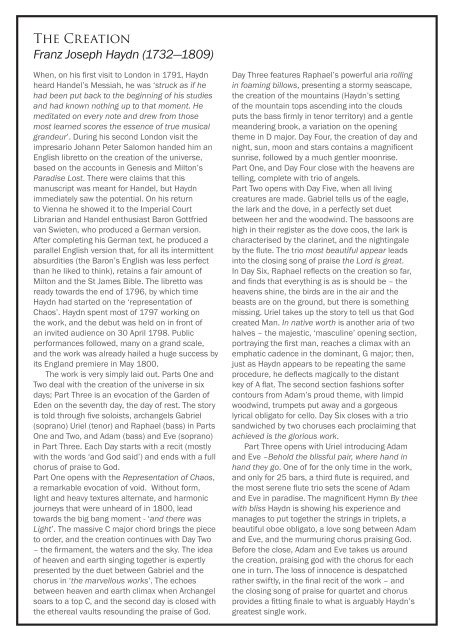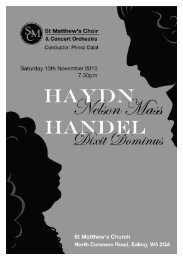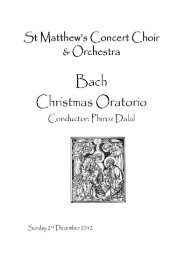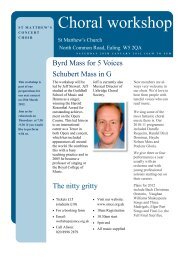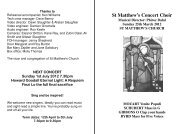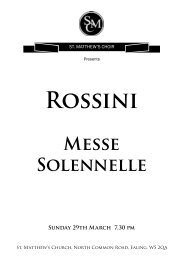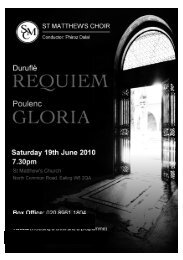Programme: £1 - St Matthew's Choir
Programme: £1 - St Matthew's Choir
Programme: £1 - St Matthew's Choir
Create successful ePaper yourself
Turn your PDF publications into a flip-book with our unique Google optimized e-Paper software.
The Creation<br />
Franz Joseph Haydn (1732―1809)<br />
When, on his first visit to London in 1791, Haydn<br />
heard Handel’s Messiah, he was ‘struck as if he<br />
had been put back to the beginning of his studies<br />
and had known nothing up to that moment. He<br />
meditated on every note and drew from those<br />
most learned scores the essence of true musical<br />
grandeur’. During his second London visit the<br />
impresario Johann Peter Salomon handed him an<br />
English libretto on the creation of the universe,<br />
based on the accounts in Genesis and Milton’s<br />
Paradise Lost. There were claims that this<br />
manuscript was meant for Handel, but Haydn<br />
immediately saw the potential. On his return<br />
to Vienna he showed it to the Imperial Court<br />
Librarian and Handel enthusiast Baron Gottfried<br />
van Swieten, who produced a German version.<br />
After completing his German text, he produced a<br />
parallel English version that, for all its intermittent<br />
absurdities (the Baron’s English was less perfect<br />
than he liked to think), retains a fair amount of<br />
Milton and the <strong>St</strong> James Bible. The libretto was<br />
ready towards the end of 1796, by which time<br />
Haydn had started on the ‘representation of<br />
Chaos’. Haydn spent most of 1797 working on<br />
the work, and the debut was held on in front of<br />
an invited audience on 30 April 1798. Public<br />
performances followed, many on a grand scale,<br />
and the work was already hailed a huge success by<br />
its England premiere in May 1800.<br />
The work is very simply laid out. Parts One and<br />
Two deal with the creation of the universe in six<br />
days; Part Three is an evocation of the Garden of<br />
Eden on the seventh day, the day of rest. The story<br />
is told through five soloists, archangels Gabriel<br />
(soprano) Uriel (tenor) and Raphael (bass) in Parts<br />
One and Two, and Adam (bass) and Eve (soprano)<br />
in Part Three. Each Day starts with a recit (mostly<br />
with the words ‘and God said’) and ends with a full<br />
chorus of praise to God.<br />
Part One opens with the Representation of Chaos,<br />
a remarkable evocation of void. Without form,<br />
light and heavy textures alternate, and harmonic<br />
journeys that were unheard of in 1800, lead<br />
towards the big bang moment - ‘and there was<br />
Light’. The massive C major chord brings the piece<br />
to order, and the creation continues with Day Two<br />
– the firmament, the waters and the sky. The idea<br />
of heaven and earth singing together is expertly<br />
presented by the duet between Gabriel and the<br />
chorus in ‘the marvellous works’. The echoes<br />
between heaven and earth climax when Archangel<br />
soars to a top C, and the second day is closed with<br />
the ethereal vaults resounding the praise of God.<br />
Day Three features Raphael’s powerful aria rolling<br />
in foaming billows, presenting a stormy seascape,<br />
the creation of the mountains (Haydn’s setting<br />
of the mountain tops ascending into the clouds<br />
puts the bass firmly in tenor territory) and a gentle<br />
meandering brook, a variation on the opening<br />
theme in D major. Day Four, the creation of day and<br />
night, sun, moon and stars contains a magnificent<br />
sunrise, followed by a much gentler moonrise.<br />
Part One, and Day Four close with the heavens are<br />
telling, complete with trio of angels.<br />
Part Two opens with Day Five, when all living<br />
creatures are made. Gabriel tells us of the eagle,<br />
the lark and the dove, in a perfectly set duet<br />
between her and the woodwind. The bassoons are<br />
high in their register as the dove coos, the lark is<br />
characterised by the clarinet, and the nightingale<br />
by the flute. The trio most beautiful appear leads<br />
into the closing song of praise the Lord is great.<br />
In Day Six, Raphael reflects on the creation so far,<br />
and finds that everything is as is should be – the<br />
heavens shine, the birds are in the air and the<br />
beasts are on the ground, but there is something<br />
missing. Uriel takes up the story to tell us that God<br />
created Man. In native worth is another aria of two<br />
halves – the majestic, ‘masculine’ opening section,<br />
portraying the first man, reaches a climax with an<br />
emphatic cadence in the dominant, G major; then,<br />
just as Haydn appears to be repeating the same<br />
procedure, he deflects magically to the distant<br />
key of A flat. The second section fashions softer<br />
contours from Adam’s proud theme, with limpid<br />
woodwind, trumpets put away and a gorgeous<br />
lyrical obligato for cello. Day Six closes with a trio<br />
sandwiched by two choruses each proclaiming that<br />
achieved is the glorious work.<br />
Part Three opens with Uriel introducing Adam<br />
and Eve –Behold the blissful pair, where hand in<br />
hand they go. One of for the only time in the work,<br />
and only for 25 bars, a third flute is required, and<br />
the most serene flute trio sets the scene of Adam<br />
and Eve in paradise. The magnificent Hymn By thee<br />
with bliss Haydn is showing his experience and<br />
manages to put together the strings in triplets, a<br />
beautiful oboe obligato, a love song between Adam<br />
and Eve, and the murmuring chorus praising God.<br />
Before the close, Adam and Eve takes us around<br />
the creation, praising god with the chorus for each<br />
one in turn. The loss of innocence is despatched<br />
rather swiftly, in the final recit of the work – and<br />
the closing song of praise for quartet and chorus<br />
provides a fitting finale to what is arguably Haydn’s<br />
greatest single work.


